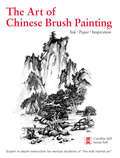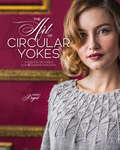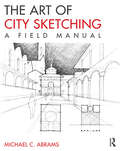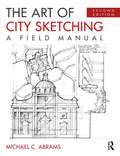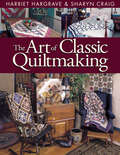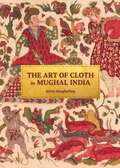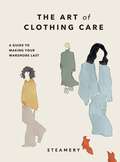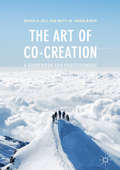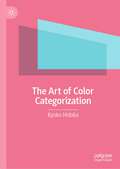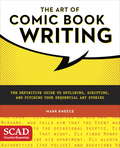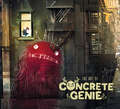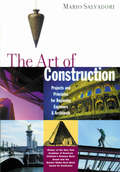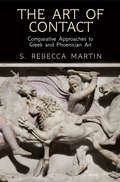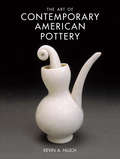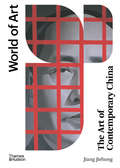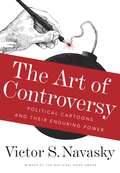- Table View
- List View
The Art of Chinese Brush Painting
by Caroline Self Susan SelfChinese ink painting is an offshoot of calligraphy and is a beautiful and reflective art that's been revered in China for centuries. A wonderfully creative tool, this book is an excellent way for newcomers to experience this ancient art form.Traditional black-and-white Chinese ink painting elements, along with the tradition's essentials--such as the quality and variety of the tools and accessories used in its practice are all covered. The Art of Chinese Brush Painting encourages readers to be mindful of the principles of composition and perspective, and introduces specific techniques for several different elements, including Chinese Zodiac animals and landscapes.
The Art of Chinese Brush Painting
by Caroline Self Susan SelfChinese ink painting is an offshoot of calligraphy and is a beautiful and reflective art that's been revered in China for centuries. A wonderfully creative tool, this book is an excellent way for newcomers to experience this ancient art form.Traditional black-and-white Chinese ink painting elements, along with the tradition's essentials--such as the quality and variety of the tools and accessories used in its practice are all covered. The Art of Chinese Brush Painting encourages readers to be mindful of the principles of composition and perspective, and introduces specific techniques for several different elements, including Chinese Zodiac animals and landscapes.
The Art of Chinese Brush Painting
by Caroline Self Susan SelfChinese ink painting is an offshoot of calligraphy and is a beautiful and reflective art that's been revered in China for centuries. A wonderfully creative tool, this book is an excellent way for newcomers to experience this ancient art form.Traditional black-and-white Chinese ink painting elements, along with the tradition's essentials--such as the quality and variety of the tools and accessories used in its practice are all covered. The Art of Chinese Brush Painting encourages readers to be mindful of the principles of composition and perspective, and introduces specific techniques for several different elements, including Chinese Zodiac animals and landscapes.
The Art of Circular Yokes: A Timeless Technique for 15 Modern Sweaters
by Kerry BogertKnit a masterpiece! Discover the how yarn and needles become artistic tools when you work on the beautiful canvas of a circular yoke. The timeless technique of knitting sweaters with nearly invisible shaping allows for painterly colorwork, illustrative lace, beautifully chiseled cables, and so much more. Open the pages of The Art of Circular Yokes to find: • Detailed information on the math behind circular yokes and how to achieve a more customized fit from designer Holli Yeoh. Plus insights into designing your own original patterns. • Curated collection of 15 stunning circular yoke pullovers and cardigans from some of your favorite designers--including Jenn Steingass, Kate Gagnon Osborn, Jennifer Wood, Andrea Cull, and others. • Projects that once knit become treasured keepsakes for years to come.No handknit wardrobe is completely with one of these iconic sweaters. With The Art of Circular Yokes you have everything you need to make an heirloom for your collection.
The Art of City Sketching: A Field Manual
by Michael AbramsThe Art of City Sketching: A Field Manual guides you through the laborious and sometimes complex process of sketching what you see in the built environment so that you can learn to draw what you imagine. Illustrated with hundreds of drawings by students and professionals of cityscapes around Europe and the United States, the book helps you develop your conceptual drawing skills so that you can communicate graphically to represent the built environment. Short exercises, projects, drawing tips, step-by-step demonstrations, and composition do's and don'ts make it easy for you to get out into the city and experiment in your own work. Author Michael Abrams uses his experience as a field sketching instructor, to show you that by drawing, you can discover, analyze, and comprehend the built environment.
The Art of City Sketching: A Field Manual
by Michael C. AbramsThe Art of City Sketching: A Field Manual guides readers through the process of freehand architectural sketching and explains orthographic, diagrammatic, three-dimensional, and perceptual-type drawings. The book presents hundreds of drawings of historic buildings and urban spaces, examples, and exercises, which help readers develop their drawing skills and employ sketching as an analytical tool. The book is divided into three parts, based on the reader’s skill level: beginner, intermediate, and advanced. As an architect and field sketching instructor, the author shows that through drawing the reader can discover, analyze, and comprehend the built environment. The new edition of The Art of City Sketching expands on the drawing techniques of the previous version by adding new drawing examples, exercises, and two new chapters—Chiaroscuro and Storyboard. New drawing tips, demonstrations, and composition "do’s and don’ts" will support readers when they illustrate their viewpoint of the city by using simple drawing tools. The lessons in this book will allow readers to mix method with imagination and sensibility.
The Art of Classic Quiltmaking: The Ultimate How-to Book For Quilters!
by Harriet Hargrave Sharyn CraigThe ultimate how-to book for quilters—a workbook with exercises that provide a foundation of much-needed basics to set you on your quilting path. Two of quilting&’s most respected teachers combine their different styles to present an incredible reference and project book that beginners and experienced quilters alike will always keep near the sewing machine! Loaded with the information you need to make traditional quilts, including selecting and caring for fabric, choosing equipment and supplies, calculating yardage, selecting the piecing technique that ensures the best result, designing borders, and deciding on quilting designs. Designed for those who encounter problems with quilting basics, from confident beginners to experienced quilters. Master piecing methods with step-by-step exercises, helpful hints, illustrations, and photos. Project quilts accompany each basic technique chapter. Numerous variations of the techniques are also presented. Find out how to answer questions such as &“where do I go next?&” or &“what went wrong?&”
The Art of Cloth in Mughal India
by Sylvia HoughtelingA richly illustrated history of textiles in the Mughal EmpireIn the sixteenth and seventeenth centuries, a vast array of textiles circulated throughout the Mughal Empire. Made from rare fibers and crafted using virtuosic techniques, these exquisite objects animated early modern experience, from the intimate, sensory pleasure of garments to the monumentality of imperial tents. The Art of Cloth in Mughal India tells the story of textiles crafted and collected across South Asia and beyond, illuminating how cloth participated in political negotiations, social conversations, and the shared seasonal rhythms of the year.Drawing on small-scale paintings, popular poetry, chronicle histories, and royal inventory records, Sylvia Houghteling charts the travels of textiles from the Mughal imperial court to the kingdoms of Rajasthan, the Deccan sultanates, and the British Isles. She shows how the “art of cloth” encompassed both the making of textiles as well as their creative uses. Houghteling asks what cloth made its wearers feel, how it acted in space, and what images and memories it conjured in the mind. She reveals how woven objects began to evoke the natural environment, convey political and personal meaning, and span the distance between faraway people and places.Beautifully illustrated, The Art of Cloth in Mughal India offers an incomparable account of the aesthetics and techniques of cloth and cloth making and the ways that textiles shaped the social, political, religious, and aesthetic life of early modern South Asia.
The Art of Clothing Care: A Guide to Making Your Wardrobe Last
by SteameryWhat would happen if we turned our back on fast fashion trends? If we took time to slow down, to take pride in caring for our clothes and making them last as long as possible? These are the questions at the heart of Steamery's mission. Since 2014, the brand has developed a wide range of products specially designed to bring out the best of your wardrobe. Now Steamery is sharing its secrets to inspire you to not only appreciate the garments you love, but to find joy in the mindful act of clothing care.With quick and simple tips, The Art of Clothing Care shows you how making small changes can go a long way in keeping your wardrobe looking wonderful.This comprehensive guide includes tips on checking a garment's quality, how to shop for pre-loved clothes, keeping your wardrobe fresh and clean without over-washing, how to remove different types of stains, simple clothing repairs and upcycling ideas, as well as inspiring thoughts on the future of fashion and clothing care.Tapping into slow fashion trends including make do and mend, upcycling, clothing rental, sustainable textiles and shopping second-hand, this beautifully designed coffee table book is the perfect way to start thinking about how you care for your clothes and what small changes you could make to keep them looking their best.
The Art of Co-Creation: A Guidebook For Practitioners
by Bryan R. Rill Matti M. HämäläinenThis book illustrates how to design and implement co-creation, a powerful form of collective creativity that harnesses the potential of teams and can generate breakthrough insights. Skilled leaders and facilitators can utilize this approach to unleash the creative potential of their organizations. Drawing from years of applied research, the authors bring together insights from the fields of design and organizational development into an evocative and pragmatic “how-to” guidebook. Taking a human-centred rather than process oriented perspective, the book argues that experience design separates true co-creation from other forms of collective efforts and design thinking. Collective moments of creative insight emerge from the space between, an experience of flow and synchronicity from which new ideas spring forth. How to create and hold this space is the secret to the art of co-creation. Collective breakthroughs require stakeholders to undergo a journey from the world of their existing expertise into spaces of new potential. It requires leaders moving from a position of dominating space to holding the space for others, and developing core capacities such as empathy and awareness so that teams can engage each other co-creatively. This book uncovers the secrets of this journey, enabling process designers to develop more effective programs.
The Art of Coding: The Language of Drawing, Graphics, and Animation
by Theodor Wyeld Mohammad Majid al-Rifaie Anna UrsynAs the title suggests, this book explores the concepts of drawing, graphics and animation in the context of coding. In this endeavour, in addition to initiating the process with some historical perspectives on programming languages, it prides itself by presenting complex concepts in an easy-to-understand fashion for students, artists, hobbyists as well as those interested in computer science, computer graphics, digital media, or interdisciplinary studies. Being able to code requires abstract thinking, mathematics skills, spatial ability, logical thinking, imagination, and creativity. All these abilities can be acquired with practice, and can be mastered by practical exposure to art, music, and literature. This book discusses art, poetry and other forms of writing while pondering difficult concepts in programming; it looks at how we use our senses in the process of learning computing and programming. Features: Introduces coding in a visual way Explores the elegance behind coding and the outcome Includes types of outcomes and options for coding Covers the transition from front-of-classroom instruction to the use of online-streamed video tutorials Encourages abstract and cognitive thinking, as well as creativity The Art of Coding contains a collection of learning projects for students, instructors and teachers to select specific themes from. Problems and projects are aimed at making the learning process entertaining, while also involving social exchange and sharing. This process allows for programming to become interdisciplinary, enabling projects to be co-developed by specialists from different backgrounds, enriching the value of coding and what it can achieve. The authors of this book hail from three different continents, and have several decades of combined experience in academia, education, science and visual arts. Source Code: The source code for the book can be accessed here.
The Art of Collaboration: Director and Stage Manager as Co-creators and Colleagues
by Jacqui George Matt BallThe Art of Collaboration explores the critical relationship between directors and stage managers. The book is an essential guide for theatre professionals seeking to build strong creative partnerships, emphasising mutual respect, clear communication and shared goals.Through real-world examples, practical strategies and expert advice, it offers a framework that stimulates collaboration, enhances the rehearsal process and promotes a seamless production.Whether you’re a seasoned director, an aspiring stage manager or simply want to know more about how to navigate the production process, this book provides insight to the vital, often-overlooked, role of teamwork in bringing performances to stage.
The Art of Collectivity: Social Circus and the Cultural Politics of a Post-Neoliberal Vision
by Jennifer Beth Spiegel Benjamin Ortiz ChoukrounAmidst epidemics of youth alienation and cultural polarization, community-based artistic practices are sprouting up around the world as antidotes to policies of austerity and social exclusion. Rejecting the radical individualism of the neoliberal era, many artistic projects promote collectivity and togetherness in navigating challenges and constructing shared futures. The Art of Collectivity is about how one such creative social program deployed this approach in service of a post-neoliberal vision. Focusing on a national social circus initiative launched by a newly elected Ecuadorean government to help actualize its “citizens' revolution,” the book explores the intersection between global cultural politics, participatory arts, collective health, and social transformation. The authors include scholars and practitioners of community arts, humanities, social sciences, and health sciences from the Global North and Global South. Sensitive to hierarchical binaries such as research/practice, north/south, and art/science, they work together to provide a multifaceted analysis of the way cultural politics shape policy, pedagogy, and aesthetic sensibilities, as well as their socio-cultural and health-related effects. The largest study of social circus to date, combining detailed quantitative, qualitative, and arts-based research, The Art of Collectivity is a timely contribution to the study of cultural policies, critical pedagogies, collective art-making, and community development.
The Art of Collectivity: Social Circus and the Cultural Politics of a Post-Neoliberal Vision
by Jennifer Beth Spiegel and Benjamin Ortiz ChoukrounAmidst epidemics of youth alienation and cultural polarization, community-based artistic practices are sprouting up around the world as antidotes to policies of austerity and social exclusion. Rejecting the radical individualism of the neoliberal era, many artistic projects promote collectivity and togetherness in navigating challenges and constructing shared futures. The Art of Collectivity is about how one such creative social program deployed this approach in service of a post-neoliberal vision. Focusing on a national social circus initiative launched by a newly elected Ecuadorean government to help actualize its “citizens' revolution,” the book explores the intersection between global cultural politics, participatory arts, collective health, and social transformation. The authors include scholars and practitioners of community arts, humanities, social sciences, and health sciences from the Global North and Global South. Sensitive to hierarchical binaries such as research/practice, north/south, and art/science, they work together to provide a multifaceted analysis of the way cultural politics shape policy, pedagogy, and aesthetic sensibilities, as well as their socio-cultural and health-related effects. The largest study of social circus to date, combining detailed quantitative, qualitative, and arts-based research, The Art of Collectivity is a timely contribution to the study of cultural policies, critical pedagogies, collective art-making, and community development.
The Art of Color Categorization
by Kyoko HidakaFrom Newton's prism spectroscopy to modern color science, the study of color has been rooted in the categorization of colors. Building upon this foundation, this book aims to explore the rich and varied examples of color theory through two basic concepts: categorizing colors themselves and categorizing things by color. How have different cultures drawn the line between colors, and why? What do these divisions reveal about color naming, standards, environments, and sensory perceptions? The book delves into these questions, shedding light on how color categorization has shaped our world. Through this exploration of color theory, the author also hopes to draw attention to the potential parallels between Western color classifications and the logic of racism. By examining various theories on color classification standards, the author seeks to unravel this complex issue and encourage readers to reflect on how our understanding of color and categorization can impact our social and cultural attitudes.
The Art of Comedy: Getting Serious About Being Funny
by Paul RyanLong-time Hollywood comedy acting coach Ryan explains how to create comedy using such tools as a comedy notebook, sketching a comedy character, and taking improvisation into the written scene. He intersperses exercises progressing from beginning through intermediate to advanced. Annotation ©2007 Book News, Inc. , Portland, OR (booknews. com)
The Art of Comic Book Writing
by Mark KneeceA practical guide for beginner and advanced comic book writers that outlines the steps needed to successfully craft a story for sequential art. With this latest book in the SCAD Creative Essentials series from the esteemed Savannah College of Art and Design, comics writer and instructor Mark Kneece gives aspiring comic book writers the essential tools they need to write scripts for sequential art with confidence and success. He provides a practical set of guidelines favored by many comic book publishers and uses a unique trial and error approach to show would-be scribes the potential pitfalls they might encounter when seeking a career in comics writing. Supported by examples of scripting from SCAD's students, faculty, and alumni,The Art of Comic Book Writing strips away the mysteries of this popular artform and provides real-world advice and easy-to-follow examples for those looking to write for the comics medium.
The Art of Concrete Genie
by PixelOpusWalk among the mysterious streets of Denska and collect the real pages of artwork behind PixelOpus' endearing video game Concrete Genie!This art book studies the power of self-expression, creativity and the game's core fantasy of making anyone believe they can be an artist - just like the talented protagonist of the game, Ash. Return to the characters, monsters, and lore of Denska to uncover the secrets behind PixelOpus' 'living paint' mechanics that allow the walls of Denska to come to life with player creations. Witness a special, behind-the-scenes look at the development of Concrete Genie from the small and passionate team that brought it to life.From the developers of a truly empowering journey about oppression and creativity, Dark Horse Books and PixelOpus are delighted to present The Art of Concrete Genie! This art book collects heart-warming, magnificent illustrations for fans of Ash and his wildly varied 'living paint' creations within Concrete Genie.
The Art of Confession: The Performance of Self from Robert Lowell to Reality TV (Performance and American Cultures #1)
by Christopher GrobeThe story of a new style of art—and a new way of life—in postwar America: confessionalism. What do midcentury “confessional” poets have in common with today’s reality TV stars? They share an inexplicable urge to make their lives an open book, and also a sense that this book can never be finished. Christopher Grobe argues that, in postwar America, artists like these forged a new way of being in the world. Identity became a kind of work—always ongoing, never complete—to be performed on the public stage. The Art of Confession tells the history of this cultural shift and of the movement it created in American art: confessionalism. Like realism or romanticism, confessionalism began in one art form, but soon pervaded them all: poetry and comedy in the 1950s and ’60s, performance art in the ’70s, theater in the ’80s, television in the ’90s, and online video and social media in the 2000s. Everywhere confessionalism went, it stood against autobiography, the art of the closed book. Instead of just publishing, these artists performed—with, around, and against the text of their lives. A blend of cultural history, literary criticism, and performance theory, The Art of Confession explores iconic works of art and draws surprising connections among artists who may seem far apart, but who were influenced directly by one another. Studying extraordinary art alongside ordinary experiences of self-betrayal and -revelation, Christopher Grobe argues that a tradition of “confessional performance” unites poets with comedians, performance artists with social media users, reality TV stars with actors—and all of them with us. There is art, this book shows, in our most artless acts.
The Art of Construction: Projects and Principles for Beginning Engineers & Architects (Ziggurat Book Ser.)
by Mario Salvadori"Introduces maturing minds to the principles that guide architects and engineers as they design and construct buildings and bridges." --School Shop
The Art of Contact: Comparative Approaches to Greek and Phoenician Art
by S. Rebecca MartinThe proem to Herodotus's history of the Greek-Persian wars relates the long-standing conflict between Europe and Asia from the points of view of the Greeks' chief antagonists, the Persians and Phoenicians. However humorous or fantastical these accounts may be, their stories, as voiced by a Greek, reveal a great deal about the perceived differences between Greeks and others. The conflict is framed in political, not absolute, terms correlative to historical events, not in terms of innate qualities of the participants. It is this perspective that informs the argument of The Art of Contact: Comparative Approaches to Greek and Phoenician Art.Becky Martin reconsiders works of art produced by, or thought to be produced by, Greeks and Phoenicians during the first millennium B.C., when they were in prolonged contact with one another. Although primordial narratives that emphasize an essential quality of Greek and Phoenician identities have been critiqued for decades, Martin contends that the study of ancient history has not yet effectively challenged the idea of the inevitability of the political and cultural triumph of Greece. She aims to show how the methods used to study ancient history shape perceptions of it and argues that art is especially positioned to revise conventional accountings of the history of Greek-Phoenician interaction.Examining Athenian and Tyrian coins, kouros statues and wall mosaics, as well as the familiar Alexander Sarcophagus and the sculpture known as the "Slipper Slapper," Martin questions what constituted "Greek" and "Phoenician" art and, by extension, Greek and Phoenician identity. Explicating the relationship between theory, method, and interpretation, The Art of Contact destabilizes categories such as orientalism and Hellenism and offers fresh perspectives on Greek and Phoenician art history.
The Art of Contemporary American Pottery
by Kevin A. HluchBeauty will always reside in the eye of the beholder, but what about the fine line between beauty and functionality? Can a purely utilitarian form, such as a simple pot, vase, or plate, truly be considered a great work of art? In The Art of Contemporary American Pottery, author Kevin A Hluch takes up the challenge of addressing this debate. Hluch, who examines pottery from a unique perspective as historian, scholar and connoisseur, finds as much meaning and nobility in a thoughtfully crafted clay vessel as he does in a masterpiece painting. There are many reasons why a good pot is a good pot. Some reasons are obvious. Some are subtle. Some only reveal themselves when you know how to look. With the help of more than 200 beautiful color photos featuring the world of the country's best utilitarian potters, and a lengthy list of artists and galleries, Hluch does more than just talk about how great pottery is made. He talks about what makes great pottery.
The Art of Contemporary China (World of Art #0)
by Jiang JiehongA redefinition of contemporary Chinese art from the last forty years in the context of unprecedented cultural, political, and urban transformation, written by an authority on the subject. Contemporary Chinese art is a subject of sustained and growing significance in present-day culture across the globe. This new volume in the World of Art series reframes Chinese art since the end of China’s Cultural Revolution more than four decades ago, placing it in the context of the nation’s unprecedented cultural, political, and urban transformation. Based on original research by writer, curator, and leading scholar in the field of contemporary Chinese art, Jiang Jiehong, this volume explores the area through firsthand materials and in-depth interviews with more than thirty artists. Providing the most up-to-date understanding of contemporary Chinese art, Jiang includes a variety of media, ranging from painting, printmaking, sculpture, and photography to installation, video, performance, and participatory art. Featuring over 150 color images of artworks by more than fifty internationally renowned Chinese artists, including Ai Weiwei and Zhang Peili, as well as emerging artists, such as Zhao Zhao, The Art of Contemporary China presents a wide variety of practices through curatorial discussions and images of original installation views and historical art events. What emerges are revelations on art, and new insights into contemporary China. Fulfilling a need for an accessible, affordable introduction to contemporary Chinese art, this volume offers a concise but far-reaching survey of the movement.
The Art of Controversy: Political Cartoons and Their Enduring Power
by Victor S. NavaskyA lavishly illustrated, witty, and original look at the awesome power of the political cartoon throughout history to enrage, provoke, and amuse. As a former editor of The New York Times Magazine and the longtime editor of The Nation, Victor S. Navasky knows just how transformative--and incendiary--cartoons can be. Here Navasky guides readers through some of the greatest cartoons ever created, including those by George Grosz, David Levine, Herblock, Honoré Daumier, and Ralph Steadman. He recounts how cartoonists and caricaturists have been censored, threatened, incarcerated, and even murdered for their art, and asks what makes this art form, too often dismissed as trivial, so uniquely poised to affect our minds and our hearts.Drawing on his own encounters with would-be censors, interviews with cartoonists, and historical archives from cartoon museums across the globe, Navasky examines the political cartoon as both art and polemic over the centuries. We see afresh images most celebrated for their artistic merit (Picasso's Guernica, Goya's "Duendecitos"), images that provoked outrage (the 2008 Barry Blitt New Yorker cover, which depicted the Obamas as a Muslim and a Black Power militant fist-bumping in the Oval Office), and those that have dictated public discourse (Herblock's defining portraits of McCarthyism, the Nazi periodical Der Stürmer's anti-Semitic caricatures). Navasky ties together these and other superlative genre examples to reveal how political cartoons have been not only capturing the zeitgeist throughout history but shaping it as well--and how the most powerful cartoons retain the ability to shock, gall, and inspire long after their creation.Here Victor S. Navasky brilliantly illuminates the true power of one of our most enduringly vital forms of artistic expression.
